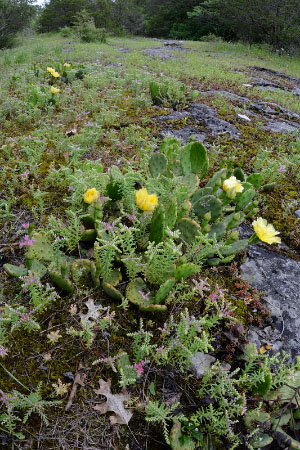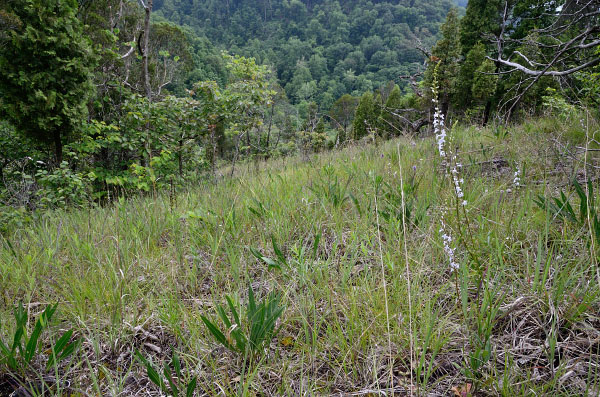
 Department of Conservation and Recreation
Department of Conservation and Recreation
Conserve. Protect. Enjoy.
 Department of Conservation and Recreation
Department of Conservation and Recreation
 Table of Contents
Table of ContentsLimestone / Dolostone Woodlands and Barrens
Exposed, carbonate rock outcrops and associated xeric rocky slopes provide the requisite habitats for the woodland and herbaceous communities of this group. These calcareous woodlands and barrens are scattered throughout the western Virginia Ridge and Valley region and Cumberland Mountains, usually occurring on steep, south- to west-facing slopes. In The Cedars region of Lee County and in central Rockbridge County, "flatrock" limestone barrens are present on gently rolling topography. The degree of exposed bedrock cover is variable, and many occurrences have considerable development of thin soils and gravel. Soils typically have high pH (> 7.0) and calcium levels; in addition, dolomitic soils have relatively high magnesium levels. Physiognomically, the communities in this group vary from open stands of stunted trees to wholly herbaceous, but often occur as patch-mosaics of woodlands and openings.

Warm-season prairie grasses, including big bluestem (Andropogon gerardii), little bluestem (Schizachyrium scoparium var. scoparium), indian grass (Sorghastrum nutans), side-oats grama (Bouteloua curtipendula var. curtipendula), and rough dropseed (Sporobolus clandestinus) characterize the herbaceous vegetation of both barrens and woodland openings. Ebony sedge (Carex eburnea) is also an abundant, sod-forming graminoid at some sites. Associated perennial forbs include western silvery aster (Symphyotrichum pratense), false boneset (Brickellia eupatorioides var. eupatorioides), eastern indian paintbrush (Castilleja coccinea), Canada bluets (Houstonia canadensis), tall blazing star (Liatris aspera), rattlesnake-master (Agave virginica), southern obedient-plant (Physostegia virginiana ssp. praemorsa), white blue-eyed-grass (Sisyrinchium albidum), low wild-petunia (Ruellia humilis), eastern shooting star (Primula meadia), hoary puccoon (Lithospermum canescens), and stiff goldenrod (Solidago rigida var. rigida). Pitcher's stitchwort (Minuartia patula), wiry panic grass (Panicum flexile), poverty dropseed (Sporobolus vaginiflorus), widow's-cross (Sedum pulchellum) and other calciphilic annuals are characteristic of exposed, gravelly areas, rock crevices, and flatrocks. Stunted trees and shrubs such as chinquapin oak (Quercus muehlenbergii), eastern red cedar (Juniperus virginiana), Shumard oak (Quercus shumardii), eastern redbud (Cercis canadensis var. canadensis), aromatic sumac (Rhus aromatica var. aromatica) and Carolina buckthorn (Frangula caroliniana) are the most characteristic components of the woodlands.
One of the rarest and most distinctive community type in this group, confined to the largely dolomitic Elbrook formation in the southwestern Ridge and Valley, features an abundance of the magnesiophiles Appalachian ragwort (Packera paupercula var. appalachiana), glade wild quinine (Parthenium auriculatum), and tall larkspur (Delphinium exaltatum), as well as populations of the federally listed smooth coneflower (Echinacea laevigata) and the globally rare, Virginia endemic Addison's leatherflower (Clematis addisonii)
Communities in this group are highly localized, small-patch units that are considered state-rare and, in most cases, globally rare. Threats include quarrying, grazing, and invasive introduced weeds.
Reference: Ludwig (1999).Click here for more photos of this ecological community group.
 © DCR-DNH, Gary P. Fleming.
© DCR-DNH, Gary P. Fleming.
The five classified community types in this group are clearly distinct, with the units segregating by geography and in some cases topography and geological substrate. However, supporting data (63 plots) were collected from relatively few discrete landscapes (Fig. 1). Wider geographic sampling of this group is needed to firm up characterization and resolve problems in crosswalking the units to similar vegetation outside of Virginia. Unfortunately, due to the rarity of this vegetation, it is unlikely that many more sites will be found in Virginia. Click on any highlighted CEGL code below to view the global USNVC description provided by NatureServe Explorer.

 Download a spreadsheet of compositional summary statistics for each of the community types listed below.
Download a spreadsheet of compositional summary statistics for each of the community types listed below.

